#not to be pretentious but as a WRITER who is in school for SCREENWRITING
Explore tagged Tumblr posts
Text
okay weewoo show season finale thoughts spoilers obviously please use your eyes because im not spoiler tagging this because i dont want it to breach containment if you haven't seen the finale simply do not click the read more
i missed ravi and may more than life itself it wasn't a great tv finale but it wasn't anywhere near got s8 (i know its not the end of the show but this is my point of comparison okay)
first of all the daddy kink debate going on in the tags is so funny to me as if this show ISNT MADE BY THE SAME PEOPLE THAT MADE FUCKING GLEE! GET A GRIP! there was NEVER going to be a time when this show is dead serious tm. there is always going to be a level of camp garbage to it, but y'all aren't ready for that discussion. actually this point doesn't just apply to the daddy kink thing, but the whole show. this isn't prestige tv. we're not watching succession here, we're watching a prime time soap opera set at a fire house.
acab. i love athena as a person but i'm honestly not a fan of her character arc in this show.
loved being right all along about amir. i knew in my heart that man could not hurt a fly.
idc how unrealistic maddie and chimney being approved as emergency foster placements that quick probably is they're everything to me and i really want more of the hen/karen & maddie/chimney joint family next season! more of that and less cop athena plots pls. (i know i'm harping on it but i really can't stand cop shows and as much as i love angela bassett i want less of athena)
i actually think eddie letting chris go with his grand parents was mature as hell. like i'm sorry dude, you fucked around and found out. i feel bad for him for not having processed his grief but i think allowing knockoff shanon (i forgot her name okay) into his house and into his life at all was a dick move on ALL fronts. i'm glad he and chris have a support system sure wished he used it more instead of putting all his grief on a fucking stranger (i also really hated this plot it was dumb and stupid and really ryan murphy core)
anywho favorite moments of the episode were may showing up, maddie calling herself 'maddie han' and jee walking in holding mara's hand.
i'm not going to rant about how much i hate 90% of the people in the fandom who aren't in the rpc. you can unlock that rant by adding me on disco cause jesus christ the people in the tags deserve jail time.
hottest take i just came up with, i think this show should be moved to a streaming exclusive and make the episodes longer. i honestly think the biggest handicap of this show is the amount of time they have. the seasons are SHORT which is the trend now for prestige tv but like i said this ain't it. an hour of 9/1/1 without commercials would really give the show room to breath cause truly when you watch it with commercials you realize how little run time it actually has. there was one point mid episode where there was ONE SCENE and then it cut to commercial again. like thats nasty.
#not to be pretentious but as a WRITER who is in school for SCREENWRITING#it makes me laugh when people read this show like its meant to be succession or the sopranos#that is not the text we're working with here and it never was#thats not to say that it doesn't have value just that there is an aspect of unseriousness a lot of people forget it's SUPPOSED TO HAVE#*[ OOC : MEDIA COMMENTARY ] . . . the chances of me shutting up are low
3 notes
·
View notes
Text
Thoughts of the Droid: Miraculous Ladybug Season 4 spoilers.
Hello, people of Tumblr! How have they fared in life? As always, I hope very well. People, a couple of days ago I learned about the existence of spoilers that reveal details of the fourth season of the Miraculous Ladybug series. Truth be told, these spoilers not only give me a bad feeling but also show in their entirety the creative problem that writers are going through, who, apparently, have run out of good ideas.
For example, we have that the characters of Kagami and Luka will be akumatized… AGAIN. What reasons will they have to be akumatized? And why precisely them, when basically there are other adolescents and even adult characters that we have not yet seen transformed into temporary villains? Not only that, but they also mention that it will finally be revealed which shipping will "win" in the future: whether Adrinette or Lukanette. Interesting detail, since at no time is Adrien and Kagami mentioned, giving you to understand that our favorite Japanese will end up losing. If you ask me, this “amazing” spoiler is everything, less amazing, for the simple reason that everyone in the fandom knew from the beginning that Marinette and Adrien are destined to be together.
But, most striking, for me, without a doubt is that they have announced a new character that will replace Chloé as Queen Bee. For those who have followed my blog and read some of my previous posts, it is no longer a secret that Chloé is one of my favorite characters in the series. So you can imagine my feeling when I hear this news. Basically, it felt like a good blow to the testicles (sorry for the expression).
It bothers me, yes, but more than anything I feel disappointed and ripped off with this change.
Why?
Well, I have the whole reasoning behind and this is where I will expand as much as I can.
First, the leaked video, even if they don't show an image, we have a lady (who I imagine is an animator or screenwriter ... or both) who describes the new Queen Bee as "She is sweet, she is not mean."
Who told you to say that line? Thomas Astruc!?
Returning to the topic, this is where I wonder: Is it really a mandatory requirement that the superheroes of this series are all sweet, kind and faultless people? (The latter is in doubt, seeing past chapters) Apparently yes, since people dislike superheroes who are dark vigilantes (Batman) or antiheroes who fight evil under their very dubious moral and ethical code, almost nonexistent (Venom, Spawn).
Oh, wait, those characters I just mentioned are popular, they have been since their beginnings and even though decades have passed, they are still very dear characters in popular culture.
With Chloé we had a bratty superheroine, pretentious and at all times she kept showing off and having a very high ego ... but still, she was a superheroine who was really able to risk her life for a common good. In addition, her personality made the dynamics of the team more interesting and entertaining. On the one hand, we had a Chloé who wanted to be a superheroine because of the emotion that it entailed. She sought to be a heroine for the attention and fame she obtained. Obviously, those two points are not commendable reasons to be a superhero, but these were eclipsed because more than anything Chloé sought to be a heroine to help Ladybug and feel useful, making a difference in the world for good. And now, with this new sweet girl, this dynamic will be forgotten.
Second, the spoilers mention that there will be more "secret siblings." That being the case, there is a possibility (remote but after all) that the new Queen Bee is a sister or cousin of Chloé. Here I will be honest and I differ with the majority of opinions I've seen about it: I would like the new Queen Bee to be Chloé's sister. It is one of the few ways I would accept, almost without questioning or protesting, this new heroine. The other way I would accept this new character is to not share any biological trait with Chloé, but to get to interact at a very personal level and, above all, to interact in a very good way, that is, despite their disparate personalities, get along very well and even be friends. Why not risk presenting this interesting scenario?
Right, the writers of the series do not like to take risks.
Third, the spoilers mention that Chloé will be akumatized… AGAIN. Which proves what I said above paragraphs: Writers are running out of ideas. If you ask me, it is already tiresome to see the same characters being akumatized over and over and over and over and over and over and over again. Of course, they change the reason why they are akumatized and the name and design change, but that does not help to make it more interesting, to the contrary, it creates the problem that the characters do not grow emotionally and with that, there is no real development of their characters.
Bitterness aside, I'm really intrigued to know the reason why Chloé will be akumatized again. And even more so if it will be a different fourth Akuma or one of its three previous forms will return. One part of me wants her fourth akumatization obeys the reason to be replaced by a new heroine. If you ask me, it would be a good reason.
Fourth and most important to me: Replacing Chloé with a new heroine will cause the little development she has had to be thrown away. Those who are fans like me of the character, will not let me lie and it has been frustrating and a disappointment after another to see a chapter where Chloé is shown more deeply, after another chapter to see how it is again an unpleasant brat.
I am going to tell you a little story and in the end, you will understand the reason for my disgust.
You see, I saw the Miraculous Ladybug series, back in 2017, about two years after its premiere in 2015. Don't believe it or not, the first season caught me the moment I saw that series. What I did was to see one chapter per day and when I finished watching it, it left me wanting more. To follow the story and its characters. As you may have guessed, Some of the chapters where they showed a little more of Chloé, made this character catch my attention and gradually become my favorite character. You cannot imagine my emotion when in those years they had confirmed that Chloé would have the Bee Miraculous and that she would be a superheroine named Queen Bee. Seeing the great results they had achieved with the first season, I assumed that in the second season I would see much more of Chloé and her training as a heroine. Which translated into more development.
Also by that time they had announced a special three chapters, "The Battle of the Queens" and whose chapters would be centered in Chloé. Imagine: more expectations were raised since it seemed to me that in three chapters they would develop Chloé better and that at the end of that special she would begin her arduous but satisfying journey to become a more dignified person and a trusted heroine. I am sincere, when I heard about this special, I did not want to see any other chapter, but only those three.
Finally, the day came when these special chapters were released.
You don't know a huge disappointment that I took away.
Wait about two years for a special that was disastrous from start to finish.
Do not misunderstand me, if there are extremely rescued scenes and moments, but they are very overshadowed by the mishandling they gave to those three episodes and something tells me that they did so on purpose to further sink the development of my favorite character.
The point is that, in my opinion, writers cannot or rather do not want to give the character an authentic redemption and development. And in fact, having this new Queen Bee has proved it that way. What bothers me most about this issue is that they are going to develop this new character, instead of giving it to Chloé. And this is where I wonder. And wouldn't it have been better to have the new character from the beginning be Queen Bee? Why did they give Chloé that opportunity, if, in the end, they weren't going to do anything significant with my favorite blonde? Why create those expectations if in the end all they do is destroy them in this outrageous way?
What was the use of seeing a Chloé feeling deep sadness and disappointment to see that her childhood friend did not arrive at school? What was the use of seeing a furious Chloé and then in bitter tears when her idol, Ladybug, told her she was a liar? What was the use of seeing a sincere smile emanating from her when she made peace with her friend Sabrina? What was the use of seeing a Chloé with fear of losing Adrien's friendship? What was the use of seeing how butler Jean comforted and encouraged Chloé? What was the use of seeing a Chloé crying bitterly when she learned that Adrien was no longer going to school? What was the use of seeing a Chloé, on the verge of tears when her mother did not consider her exceptional or even her daughter? What was the use of seeing a Chloé open her heart and feelings to Ladybug? What was the use of seeing a Chloé, fighting beside Ladybug? What was the use of seeing her as Queen Bee?
Just to give me false hopes and that in the end, all that development so little, but so genuine will end everything in the trash.
Maybe I am being a bit rude. Perhaps this new Queen Bee is a hoax, as it was years ago the supposed existence of Amber. Maybe it's just to distract us. Maybe now if they give her the development that Chloé needs. Maybe so. I want to believe it. I really want to believe it ...
But I don't have many expectations after this spoilers.
Moreover, I do not make expectations so high and hopeful, for the simple fact that lately, the series has left much to be desired with this third season.
If basically the writers give Marinette a vexatious and humiliating treatment, to the sweet Marinette, to Marinette who is “our everyday Ladybug”, to Marinette who has always shown to possess a pure and kind heart, to Marinette, a character so laudable that we need this way in our real world, to the character that Astruc insists on that you must support and not Chloé….
So what's left for me as a fan of Chloé Bourgeois?
This is all I have to say about it. Of course, when all these chapters that have announced the fourth season comes out, rest assured that I will make the respective reviews. In spite of everything, I will continue to stay with the series for a while, especially for the good times that the fandom has provided me and will continue to do.
With this, I feel that I have finally relieved myself.
Thank you for reading.
Greetings
Rankakiu
#miraculous ladybug#miraculoustalesofladybugandcatnoir#tales of ladybug and cat noir#miraculous tales of ladybug and chat noir#ml ladybug#ml spoilers#ml leaks#ladybug spoilers#chloe bourgeois#chloé bourgeois#queen bee#ml queen bee#a little of ml salt post#opinions#thoughts#honestly though#seriously though#rankakiu
37 notes
·
View notes
Text
I feel like a lot of anti-intellectualism AND elitism in media analysis actually has the same root-logic. The idea that 'Undersanding Cinematic Language' (I'm using film as an example, since anti-intellectualism in flim fandom is kind of a Thing right now. But you can put in “Metaphors in Literature”, or “Video Games as Art” and so on instead) is some sort of super-secret brain magic that only the Smart People can do - rather than something all filmwatchers do.
It's just the difference between "This is for the elites, the Regular People can't even understand them and I am better than them and none of them have smart things to say" and "This is for the elites, so why should Normal People like us even bother to try?"
"Cinematic Language" might sound like a bit of a pretentious term, but it's exactly what it is - a Language. The way films communicate their ideas to the audience without just saying "He's the good guy so you should feel good that he won" directly to us. If you can watch a movie and identify who are the good guys and who are the bad guys, when are you supposed to feel sad or that the train is not - in fact - gonna run you over... You know the Cinematic Language. At least the basics of it.
Obviously there are different levels to this stuff, between "Well this guy wears all-black so he's the bad guy and this lady wears all white so she's a good guy" and like... RGU Color Symbolism Essays. But it's important to remember that it's all built on the same foundation.

It's not a completely separate, inscrutable scary thing up on some ivory tower - you start with "ah Peridot is standing in the cleansing rain that washes away her misdeeds and brings new beginnings to start her redemption arc!" and then just... try and think about other stuff more. And trying to *directly resist it* cause some people ARE elitist about it is just gonna lead to totally idiotic reads even of clearly communicated stuff meant for everyone to understand!
And if someone’s gonna say “Oh so we’re just supposed to think a scene is sad cause the music and cinematography tells us it’s sad? That’s manipulative” Lemme just say it directly: all works of fiction is inherently "manipulation".
Manipulation is a bad word in terms of like... interpersonal relationships and stuff like that. Stuff that involves reality. But fiction IS a sort of emotional manipulation. The creators want to feel a certain way about something... something that isn't even real and not happening to real people - and they make you feel that way using music and words and framing and colors and metaphors and editing and lighting.
When people say a work of media is "Manipulative" what they mean is usually that the manipulation wasn't subtle enough. There's a reason why we HAVE cinematic language and we don't just write "this characer is the good guy FEEL HAPPY WHEN THEY WIN" on the screen. And I would say that "All fiction 'manipulates' you into feeling something" is an obvious statement but remember that one tweet about the person who though The Shining was manipulating them cause it used music to scare them? So, you know...
And that's honestly just the most famous example! There's so many Bad Takes from People Who Don't Undertand How Art Works online that are like "Aurgh, that movie tries to makes us like the good guy cause he saves a puppy? How MANIPULATIVE!” Fiction is about making you Feel Things about made up stuff! We read a sad book cause we want the writer to make us feel Sad, because we want them to 'manipulate' us into feeling sad about just some words on page. We watch a romantic movie cause we want the movie to manipulate us into being involved in the relationship between those two made-up people. Who were written on a paper by a screenwriter and played by actors and are projected on the screen with light and technology. The issues arise when this manipulation is too obvious and unsubtle, or when it just flat-out doesn’t work.
This manifests in a very intersting manner in video games. There's a fairly-popular school of though about game design that the best way to make your game world feel "real" is to be as close as possible to being a simulation to real life. And that games achieving that feeling of 'Realness' through smokes-and-mirrors is somehow bad and dishonest and not just... a part of Art.
It's okay if the 'city' isn't an entire modeled open world and it's just feels alive from whatever bits you did render for the game. I remember the first time I thought about it, I was watching a Portal 2 Let's Player. It was the start of "The Fall", where you're walking around the ruins just after... well.. the fall. The LPer was really excited about being outside of a testing area. They said they really felt free and like they can go anywhere they want! As they went down the one, linear path that the game allows you to go. As someone who watched too many Portal 2 LPs to count, I should know.
For a moment I thought "oh this is akward, they got it all wrong!" And then I thought about it more and I realized "Does it matter?" Does it matter that there's only one linear path even though in the story you're totally off the rails? Does it matter when the presentation makes it FEEL like you're just going wherever and exploring? Masking your linear path in a way that makes it look like the player is not actually on rails, making it just look like random wreckage, while also attraction your attention and making it where you WANT to go... That's what we like to call "Good fucking game design”. Like, REALLY GOOD.
As another example, the Photoshop Flowey at the end of the Undertale Neutral Run? It’s not that tough - if you look at it from a purely mechanical standpoint. There’s like, Five Mid-Boss Checkpoints, all the patterns are dodgeable, lot of invincibility, the damage is pretty forgiving... But it doesn’t FEEL like that wehn you’re playing through it. Cause you’re not just seeing the nuts and bolts of the fight, you’re seeing THIS.
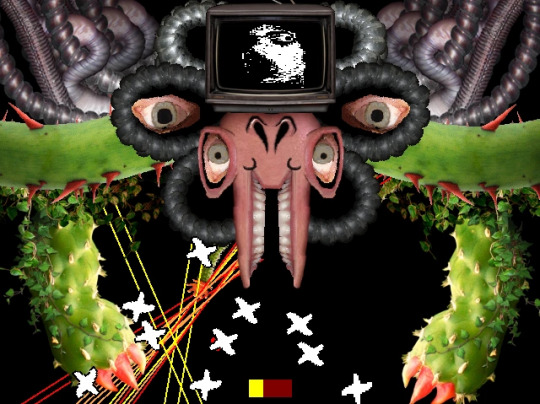
The presentation of the battle; from the background of what happened just before it, Flowey’s design and the designs of his attacks, the fact that everything that’s going on totally overturns the established conventions of the game, the music, hitting FIGHT and only taking down one HP, the game closing down every time you lose... all of this battle feel very formidable. And it does effect how you experience it! You feel like you’re struggling by the skin of your teeth through all the battle and whatever forgiveness it gives you is not always easy to notice. This is also some Good Fucking Game Design. You see a lot of skilled players fuck up the Flowey battle because, although mechanically they might be able to one-shot it, the battle just FEELS so hopeless that it effects the way they play.
Battling against Photoshop Flowey can’t be exactly as hard as fighting against a Near-God. You want all of your players to see the Neutral Ending and it’ll be one hell of a diffculty spike - and having to replay it over and over and over a billion times would just get frustrating. And Weird considering in-universe you have lost your SAVE Abillity and are only able to start again because Flowey wants to play with you still. (Unlike the Sans Fight where reloading over and over became Part of the Point). It’s just important that it feels like fighting against a Near-God.
So no, it really does not matter that a game path is linear if you can manipulate your audience into thinking that it's free. It does not matter if your NPC CAN respond to all situations, just enough to make them feel like a person for us. The lines between a boss that feels challanging and a boss that is so on a pure mechanical level is quite blurry. Art is Manipulation, Video games are Art
18 notes
·
View notes
Text
%news%
New Post has been published on %http://paulbenedictsgeneralstore.com%
Jagged Little Pill arrives on Broadway as a musical with angst to spare: Review - Entertainment Weekly News

Jagged Little Tablet (musical)
“Ooh, this could accumulate messy,” sings the ensemble of Broadway’s Jagged Little Tablet on the tip of Act 2. It’s in actuality barely from “Palms Natty” — no longer a tune from the eponymous 1995 Alanis Morissette album that inspired your complete musical, however relatively from Below Rug Swept, the Canadian singer-songwriter’s 2002 birth.
Jagged Little Tablet is, indeed, messy: chaotic, advanced, overstuffed, manner ambitious, and savagely emotional. But any Gen Xer who fell in treasure with Morissette’s album 25 years ago and performed it on repeat in her dorm room in Michigan remembers loving it for correct that motive. “And I’m here, to remind you/ Of the mess you left while you occur to went away,” goes one lyric from the brilliantly vicious breakup tune “You Oughta Know” (sung, or relatively shredded, on Broadway by Lauren Patten — more on her neatly-known particular person-making performance later). Who’s timorous of a dinky mess?
In no design Diablo Cody, the whip-natty Oscar-profitable screenwriter (Juno) tasked with taking Morissette’s anthems and patching them into a workable spot (direction is by Diane Paulus, of Waitress and Pippin standing). She begins with a character named Mary Jane “M.J.” Healy (Elizabeth Stanley) — inspired, for certain, by Morissette’s “Mary Jane” — a Connecticut supermom who makes use of oxycodone to survive the day-to-day indignities of suburban better-center-class life. (“I’ve gotten to some extent the effect I will’t feel anything!” she chirps proudly.) M.J.’s husband, Steve (Sean Allan Krill), is a workaholic with a hardcore porn behavior. Their 18-twelve months-worn son, Carve (Derek Klena), is a Harvard-breeze sq.-jawed image of Americana perfection (cue Morissette’s “Excellent”: “Don’t fail to take into accout to design shut first dwelling/ Don’t fail to take into accout to defend that smile on your face”). And their 16-twelve months-worn adopted shaded daughter, Frankie (Celia Rose Gooding), is a bisexual activist with a penchant for protests and barely-there jean shorts (Emily Rebholz designed the awesomely grunge-dapper costumes); naturally, she clashes along with her athleisure-clad mother at each flip.
Jagged‘s script is artful however no longer unpleasant, quirky however no longer unrelatable. When Frankie calls her mother “the literal worst,” her girlfriend Jo (Patten) comes aid with this zinger-gash-reward: “No manner, your mother is iconic! She’s one salad a ways from a psychotic ruin. I live for it.” And Jo has her cling parental factors. “Dear Jesus,” prays Jo, imitating her Bible-beating mother, “please don’t let my most realistic doubtless baby be a homosexual. Especially no longer a form of evident gays who wears performance fleece and utility sandals. In the title of Fox Recordsdata, Amen.”
Cody also smartly units the enduring “Ironic” in a writers’ workshop, the effect a bunch of clever-ass youth leap all around the tune’s lyrics. (Morissette is a extraordinarily correct sport.) “An worn man grew to alter into 98/ He won the lottery and died the next day to come/ It’s a shaded skim for your Chardonnay/ It’s a loss of life row pardon two minutes too leisurely/ And isn’t it ironic, don’t you rep…” sings Frankie. Interrupts one heart-broken student: “Protect up, wait a 2d, that’s in actuality no longer ironic?” Provides a pretentious one: “Gorgeous? If we’re using irony as outlined in Greek tragedy, I don’t stumble on how, like, a skim for your beverage applies…” One other piles on: “That’s no longer irony, that’s correct, like, s—ty.”
Because here's 2019 — and no longer fantasyland — Cody complicates issues extra with a sexual assault at a drunken high college celebration. The girl, Bella (Kathryn Gallagher, heartbreaking) used to be blackout inebriated; the boy, Andrew (Logan Hart), is rich. No one, along with Carve, did anything to intervene. It is, alternatively, nastily debated on social media. We stumble on your complete ingredient later, reenacted as an out-of-body dance — overchoreographed by Sidi Larbi Cherkaoui, whose unusual movement here is in every other case relatively striking — to the tune of “Predator,” a new Morissette tune. (A chunk bigger than half the numbers in the present are from JLP; there are also a few from Supposed Old school Infatuation Junkie and Below Rug Swept, a pair new ones, and even a tune from the 1998 Meg Ryan–Nicolas Cage film City of Angels.)
Along the vogue, we plow by design of protests, marriage counseling, aid-alley opioid ratings, bitchy Connecticut espresso klatches, an overdose, and an awfully terrible breakup. That’s when Jo discovers Frankie in mattress with but any other classmate, Phoenix (Antonio Cipriano) — “He used to be carrying canines tags with out a shirt like a douche,” Jo yells — and vents with “You Oughta Know.” Patten begins the first halting words in nearly a advise: “I want you to take cling of / That I’m comfortable for you.” But as the tune builds in volume and depth, it’s determined she’s no longer merely singing; she’s making an are attempting to tug the treasure out of her body. It’s an emotional exorcism — and a performance that leaves her, and the audience, exhausted and exhilarated after its rock-concert-level conclusion.
“You Oughta Know” is also one in all the few songs that sounds dynamite. Tom Kitt, the Pulitzer Prize–profitable Subsequent to Typical composer, did the tune supervision, orchestrations, and preparations (he did the same for Head Over Heels, that contains the tune of the Fling-Fling’s, and the Green Day musical American Idiot). However the sound mixing on the Broadhurst Theatre is doing his work — and Morissette’s — no favors. Too essentially singers, especially Stanley, discontinue up in a shouting match with the musicians. (Spoiler: The orchestra will constantly design shut.) And in the finale — a sun-saturated self-actualization ensemble amount paying homage to Subsequent to Typical’s “Gentle,” Spring Awakening’s “The Track of Red Summer season,” and Dear Evan Hansen’s “All we stumble on is sky.… All we stumble on is gentle” finale — when we sooner or later accumulate a snippet of “Thank U,” Morissette’s 1998 harmonious hymn to gratitude, it’s obliterated by the “You Learn” counterpoint. Well, as a clever lady as soon as acknowledged…you live, you study. B
Connected assert:
Alanis Morissette announces Jagged Little Tablet 25th anniversary tour dates
Gaze the solid of Broadway’s Jagged Little Tablet accumulate ‘You Learn’ in new video
Gaze Alanis Morissette impart ‘You Oughta Know’ whereas busking on the NYC subway in hide
Jagged Little Tablet (musical)
form
Stage
Vogue
Musical
Premiere
12/05/19
director
Diane Paulus
Total Coverage
Jagged Little Tablet (musical)
0 notes
Text
Epic Movie (Re)Watch #113 - Groundhog Day
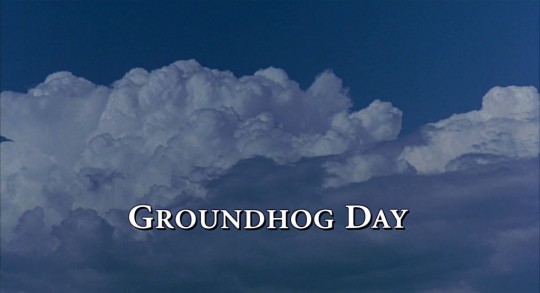
Spoilers Below
Have I seen it before: Yes
Did I like it then: Yes.
Do I remember it: Yes.
Did I see it in theaters: No.
Format: DVD
1) This film is a holiday classic associated with one of the less popular American holidays out there. Hell, this film probably made Feb. 2nd an even bigger deal than it was before.
2) The first thing we experience as an audience member of George Fenton’s quirky score over the opening credits. Fenton’s music I think is one of the more underrated aspects of the film as there is a lot of range to this particular score. There is the quirky comedy music, the kinda faster actiony stuff, but my favorite part is the romantic score featured in this film. You should give the soundtrack a listen if you have the opportunity, it’s pretty damn good.
3) Bill Murray as Phil Connors.

Director Harold Ramis, who frequently collaborated with Murray (mostly notably in the two Ghostbusters films) originally wanted Tom Hanks to play Phil but thought he was, “too nice,” and hired Murray instead. That’s great for us as the audience, because the role is one of Murray’s best. He is able to believably take us through this journey of character, playing the lovable but jerky Phil in the beginning with just as much believability as the guy who’s actually trying to do some good at the end. Murray’s improv is on full display with the film and that helps with the reality of his character.
Unfortunately, this would be the last film Murray and Ramis would collaborate on. An ongoing debate between whether the film should be more dramatic (Murray’s stance) or comedic (Ramis’ stance) was a contributing factor. As well as this, according to IMDb:
Bill Murray was undergoing a divorce at the time of filming and was obsessing about the film. He would ring Harold Ramis constantly, often in the early hours of the morning. Ramis eventually sent writer Danny Rubin to sit with Murray and iron out all his anxieties, one of the reasons why Murray stopped speaking to Ramis for several years.
I don’t know if they ironed out their issues before Ramis’ untimely death in 2014, but I hope so.
4) Chris Elliott as Larry.
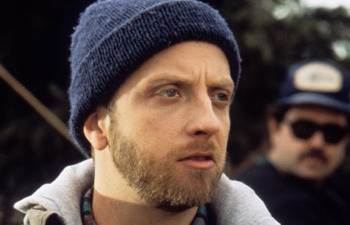
This is probably Elliott’s most famous role, which is saying something considering he’s mostly the comedic camera man who’s tired of Phil’s bull. But Elliott’s performance makes it funny and memorable, delivering some of the best lines in the films (more on that later).
5) Andie Macdowell as Rita.

Rita is actually a character who is surprisingly well developed but in a lot of little ways, and I’ll elaborate more on that as I go. MacDowell is wonderful in the part, making Rita a positive upbeat person but believably so instead of just a “life force” character. She plays Rita (and it is written) with some flaws too which helps make her interesting, but again more on that later. Her biggest asset is probably that she can hold her own with Bill Murray in a scene. You can tell (or at least I can guess) in certain scenes that Murray is improvising and that MacDowell is sharp on her toes with a comeback. It makes their relationship a believable one. Especially considering there is a line later how Phil fell for Rita as soon as he saw her. You can sort of see that when you look for it. It’s small, but it’s there. A testament to both actors.
6) Although this film takes place in Punxsutawney, PA it was actually filmed in Woodstock, IL. I was there back in fall of 2015 and the town square where they filmed most of it is pretty much still the same. They even have a black on the corner where Bill Murray stepped into the really bad puddle. It was pretty cool. (Only this time however did I realize one of the signs style reads “Woodstock Jewelers”.)
7) Remember how I said Larry has some great lines/observations?
Phil [after Rita says she booked him a nice hotel]: “You know I think this is one of the traits of a really good producer: keep the talent happy.”
...
Larry [to Rita, after Phil has left]: “Did he just call himself the talent?”
8) “I Got You Babe”, the Sonny & Cher song that plays every morning when Phil wakes up, was the song that was in the very first draft of the script and carried through until the end. The song probably became more popular (or at least, popular for a longer time) BECAUSE of its use in this film.
9) Ned! Ryerson!
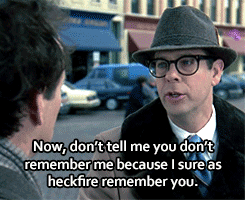
Like a lot of characters in this film, Ned Ryerson could have just been a throw away and forgettable little gag. This guy who supposedly knows Phil from high school and is an insurance agent now. But actor Stephen Tobolowsky totally MAKES this role. There’s nothing insincere about Ned. He doesn’t feel like a leech, he feels like an overly enthusiastic and genuine guy who’s absolutely hysterical. Tobolowsky plays Ned over the top in the tradition of Abbott & Costello and it works wonderfully!
Also Ned has the best lines.
Ned: “Am I right or am I right or am I right? Right? Right right right right!”
Ned: “Watch out for that first step there, it’s a DOOZEY!”
These lines on there own are not necessarily interesting but Tobolowsky just gives them such life it is a treat to watch.
10) This film has so many great lines.
Police Officer [when Phil is out in the street in a blizzard, trying to get to Pittsburg]: “Now you can go back to Punxsutawney, or you can freeze to death.”
[Phil takes a minute to stand in the snow. He looks back at Punxsutawney and then at the road ahead.]
Phil: “I’m thinking.”
11) There is never an explanation given as to why Phil is relieving Groundhog Day over and over again. I think in one draft of the script it was a spell cast by a jilted lover, but in the final film and for most drafts there’s no explanation. I think that’s the reason the film works so well. It’s not some Harry Potter fantasy. It’s just a comedy/drama with one fantasy element.
12) It’s fun rewatching this film again because you get to realize that characters who just have a throw away line earlier in the film end up being like Phil’s piano teacher or the drunks he meets a few Groundhog Days later.
13) I love that when Phil asks Rita for a good hard slap across the face she doesn’t hesitate and he’s not pissed about it. They’ve got each other. ;)
14) This line.

15) I like that Phil always goes to Rita for help with his Groundhog Day problem. She has no experience with this! There’s no reason for him to go to her with his problems other than he trusts her and respects her.
16) Hey look, it’s director Harold Ramis!
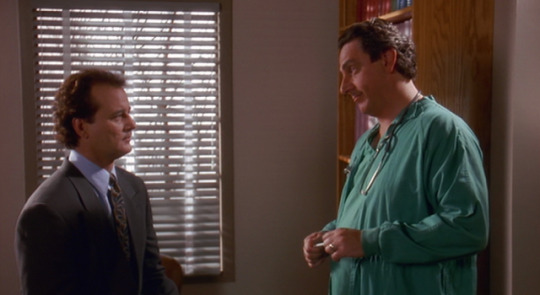
17)
Phil [to two drunks]: “What would you do if you were stuck in one place and nothing you did mattered?”
Drunk: “That about sums it up for me.”
18)
Phil [after one of the drunks decides not to drive and stumbles]: “You wanna throw up here or you wanna throw up in the car?”
Drunk: “I think...both.”
19)
Phil [while driving towards a train on train tracks]: “I’m betting he’s gonna swerve first.”
20) When Phil realizes his actions don’t have consequences the film gets fun real fast.
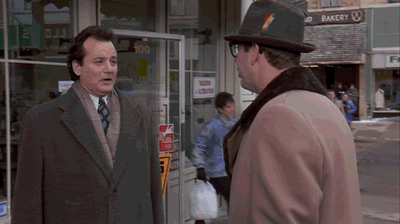
21) I find it a little pretentious that Rita’s reaction to this:
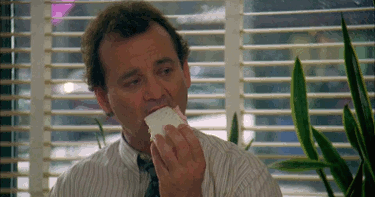
Is to quote a Sir Walter Scott poem at him which says he’s egotistical. Like, really? You’ve got this whole poem memorized JUST to call people egotistical? I mean I like it from a writing standpoint, it makes her kind of flawed, but also she comes off as pretentious. Not that she’s wrong, it’s just she’s very in your face with it.
22) The original plan for this film is that we as the audience would not see the start of the loop, instead just picking up on an “average” day and wondering how Phil knew the things he did. Harold Ramis promised he wouldn’t change this to the screenwriter but ended up changing it anyway (I think with the screenwriter’s blessing, but maybe not). I think this works better. It allows us to invest in Phil as a character more.
23) Phil’s attempts to seduce Rita - I think - start out with him trying to genuinely get to know her. He asks her about her life and only then goes down the route of, “Who’s your perfect guy?” I think he does have real feelings for her he just doesn’t know how to handle them in a healthy way so he uses this time loop to his advantage.
24) It’s interesting to see the repeated attempts of Phil trying to win over Rita, with each mistake done over until it’s not a mistake. You can tell that each time is a little less sincere, and the times when they connect the most are typically when he’s being honest with her and just letting things happen.
25) Another flaw of Rita’s:
Rita: “What should we drink to?”
Phil: “To the groundhog!”
Rita: “I always drink to world peace.”
THEN WHY THE HELL DID YOU ASK HIM WHAT YOU SHOULD DRINK TO!?!? I like it, it fleshes out her character, but it’s an annoying thing to find in a real person (and I know men and women who act like this).
26) I have so many questions.
Rita [on her ???? date with Phil]: “Do you ever have deja vu?”
Phil: “Did you just ask me that?”
This is the only time we EVER have another character show a hint of someone being aware of something is going on. WHY RITA!?!? WHY NOW!?!? WHAT IS HAPPENING!?!?!?
27) The best example of what I was talking about in note 24 is the snowball fight Phil & Rita have with the kids. Phil didn’t know that was going to happen, he didn’t know what Rita was going to say, that’s the first time he ever got that far. And he’s being honest with her! It’s such a nice scene between the two of them. And then when he tries to recreate it the next Groundhog Day it feels super awkward, incredibly forced, and wildly uncomfortable.
28) I think this is such an incredibly important concept.
Phil [after Rita says he’ll never love anything because he only loves himself]: “That’s not true! I don’t even LIKE myself!”
Keeping this in mind as Phil begins his downward spiral tells you A LOT about his character. And it’s that downward spiral that pushes this film from fun comedy to great movie.
29) And you thought this would be a light hearted comedy!
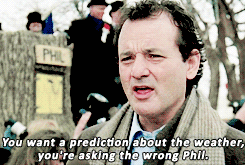
Phil: “I’ll give you a winter prediction. It’s gonna be cold. It’s gonna be gray. And it’s gonna last you the rest of your life.”
30) At one point Phil throws his radio on the ground and the speaker/song is still going.
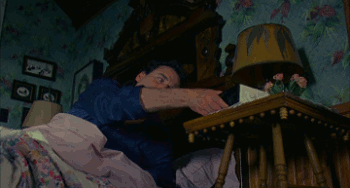
According to IMDb:
The scene where Phil picks up the alarm clock and slams it onto the floor didn't go as planned. Bill Murray slammed down the clock but it barely broke, so the crew bashed it with a hammer to give it the really smashed look. The clock actually continued playing the song like in the movie.
31) The entire scene with the car chase and the quarry, where Phil kidnaps the groundhog and attempts suicide (which is a more entertaining scene than it sounds), is very well done. It shows just how desperate Phil is to end this nightmare. And it also gave us some pretty great lines.
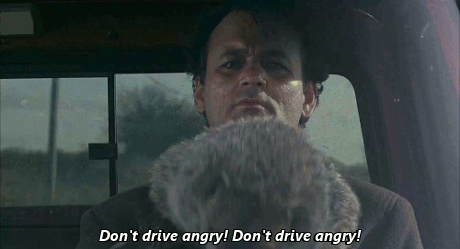
Larry [after Phil drives into the quarry and the car crashes]: “He might be okay. (Car explodes) Well no, probably not now.”
32) The montage of Phil’s attempts at suicide is good for two reason: it gets across where he is at this point in the film, and it’s short. If it were too long this scene would get too depressing too fast.
33) I love this fucking scene.
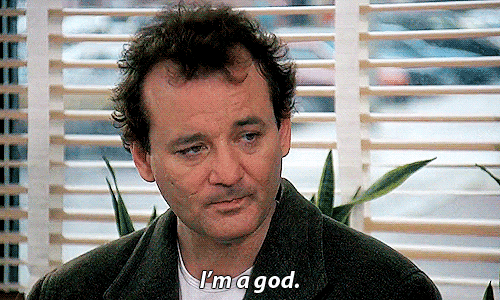
Phil has relieved the same day over and over again for what has probably been years and he’s so damn tired he just wants to talk to someone about it. So what does he do? He goes to Rita. He tries to convince Rita and succeeds wonderfully. This scene is a prime example of this film’s beating heart, of why it’s a great feel good movie. Phil knows everybody! He knows all their stories, their names, everything about them, because he’s been living the same day over and over again. It’s wonderful. Even without trying it all just sinks in. And guess what? He knows Rita the best.
Phil: “You like boats but not the ocean. You go to a lake in the summer with your family up in the mountains. There's a long wooden dock and a boathouse with boards missing from the roof, and a place you used to crawl underneath to be alone. You're a sucker for French poetry and rhinestones. You're very generous. You're kind to strangers and children, and when you stand in the snow you look like an angel.”
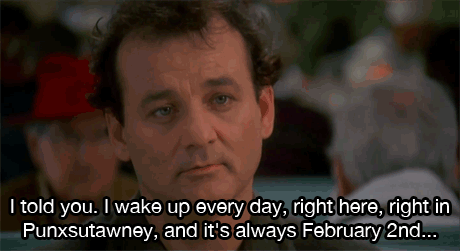
THIS is why I love this film! This emotion! This heart! And there is a beautiful piece of score on the soundtrack called, “You Like Boats But Not The Ocean,” which sums those feelings up perfectly in music and I love that too! Everything about this just makes me feel good! Also how strange and insightful a little detail about Rita like, “you like boats but not the ocean,” is!
34) And so begins the good Phil tour. The amazing final act of the film where Rita has convinced Phil that he can maybe do some good with this “curse” of his and which carries the same wonderful emotion that was present in the diner scene where Phil convinces Rita he’s serious.
35) Bill Murray improvised this:
Phil [after Ned comes up to meet him and he hugs Ned]: “I don’t know where you’re going but can you call in sick?”
36) But even as Phil works to helps people’s life, he can’t save everyone.
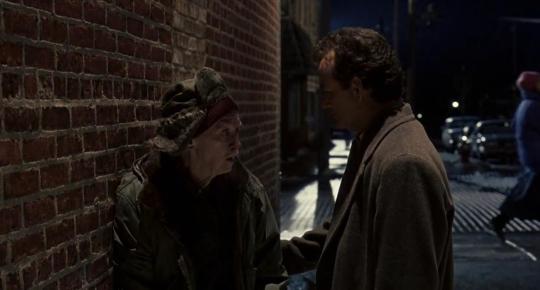
This old homeless man is someone who Phil passes everyday and, when he starts acting kind, gives a ton of money to everyday. Towards the end of the film Phil meets the man and takes him to the hospital where he dies. So the next day Phil tries to save him. He takes him to a restaurant, gives him a big meal, and the man still dies. The man dies everyday. And that scene is heartbreaking and adds such weight to the film and I love how sad it makes me every single time.

I wish I were this kind, but honestly I’m scared to be. I’m scared to be taken advantage of but there are people out there who need help and hopefully I’ll be better about giving it in the future.
37) If you pay attention to the people in the background at the hospital you’ll see this kid:
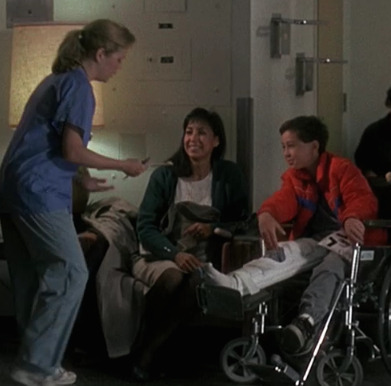
Remember that kid. You only notice him when you’ve watched the film ten times (that’s not a hyperbole either), but remember him.
38) The final Groundhog Day is a wonderful thing to behold. It starts with us hearing the end of Phil’s report on the groundhog.
Phil: “When Chekhov saw the long winter, he saw a winter bleak and dark and bereft of hope. Yet we know that winter is just another step in the cycle of life. Put standing here amongst the people of Punxsutawney, and basking in the warmth of their hearts and hearths, I couldn’t imagine a better fate than a long and lustrous winter. From Punxsutawney, it’s Phil Connors. So long.”
And EVERYONE is paying attention to it, hell rival news networks are recording it! It’s THAT moving!

39) Do you remember the kid?
youtube
Continuity! (Boom)
40) The final party is a great scene too. It’s the culmination of probably Phil’s best Groundhog Day yet. He helped as many people as he could and even plays for their pleasure at the party. It is his least selfish and the only time in the film we ever see the party, even though it was happening every single night. And also Rita spends $300+ to win Phil in a bachelor auction when the highest bid before that was $60.
41) Kneel before Zod!


42) I love this.
Phil [after ice sculpting Rita]: “I know your face so well I could’ve done it with my eyes closed.”

43) And then tomorrow finally happens.
youtube
A great end to a great film.
Groundhog Day is just amazing. It has a heartwarming story, a feel good vibe, an intriguing concept, and a wonderful cast. It is just so good for so many different reasons and if you haven’t seen it yet you should. Right now.
#Groundhog Day#Bill Murray#Andie Macdowell#Harold Ramis#Chris Elliott#Epic Movie (Re)Watch#Movie#Film#GIF
27 notes
·
View notes
Text
Her Own Story: A Nora Ephron Appreciation
This review was originally published on March 28, 2016 and is being republished for Women Writers Week.
Nora Ephron has been portrayed on screen by Diane Keaton, Sandra Dee, Meryl Streep, and Streep’s daughter, Grace Gummer. And that’s just the characters based on her life; her wit and insight are reflected in dozens of other characters she created as well.
Nora’s writer mother Phoebe taught her that “everything is copy.” Even as she was dying, she ordered Nora to take notes. All four Ephron daughters became writers, but Nora, named for the door-slamming heroine of Ibsen’s A Doll’s House, most of all mined her own life and those around her for material. She is best remembered as the writer and/or director of four of the most successful romantic comedies of all time: “When Harry Met Sally...” (1989), “Sleepless in Seattle” (1993), “You’ve Got Mail” (1998), and “Julie and Julia" (2009). The glossy charm of those films, and, let’s face it, their marginalization as “chick flicks,” makes it easy to overlook just how smart they are. For decades, no other romantic comedies have come close in quality or influence, despite the best efforts of various adorkable Jessicas and Jennifers confronting cutely contrived misunderstandings with Judy Greer as the quirky best friend.
Nora was the oldest daughter of screenwriters Henry and Phoebe Ephron (their story is told in Henry’s memoir, We Thought We Could Do Anything). They were New York City playwrights lured west to adapt established works like “Carousel” and “Daddy Long Legs” for Hollywood. Their four daughters grew up in Beverly Hills while the Ephrons worked on films like “Desk Set,” starring Spencer Tracy and Katharine Hepburn, “There’s No Business Like Show Business,” with Ethel Merman and Marilyn Monroe and “Captain Newman, M.D.,” with Gregory Peck and Tony Curtis. Phoebe wrote to Nora at camp describing the scene outside her office on the studio lot: a special effects crew creating the parting of the Red Sea for “The Ten Commandments,” using blue Jell-O.
The Ephrons often entertained their friends, mostly other New York writers, and Nora grew up listening to complicated, challenging, witty—sometimes relentlessly witty—people. She remembered Dorothy Parker playing word games at her parents’ parties. Nora dreamed of being the Parker-esque queen of a new Algonquin Roundtable: “The only lady at the table. The woman who made her living by her wit.”
The Ephrons did not hesitate to use each other's lives as material. Even Nora’s son, Jacob Bernstein, produced a superb documentary about his mother, which is of course titled "Everything is Copy." It tells the story of Nora’s sister Delia putting her head through the bannister rails in their house, so that the fire department had to come and get her out. The Ephrons made that into an incident in a James Stewart film they wrote called “The Jackpot.” “My parents just took it and recycled it, just like that,” Nora says in the film. Later, Nora’s letters home from college inspired her parents to write a successful play called “Take Her, She’s Mine,” which became a movie starring Sandra Dee as a free-spirited (for 1963) daughter and James Stewart as the lawyer father who tries to keep her out of trouble.
Phoebe and Henry were not the kind of parents who came to their children’s school events or comforted them reassuringly. Phoebe would respond to her daughters’ stories of heartbreak or disappointment by telling them it was all material for them to write about. She had a biting humor, sometimes at her daughters’ expense. But the Ephrons taught their daughters how to tell stories, especially their own stories.
After college, Nora went to New York to work as a “mail girl” for Time magazine. News magazines of that era did not allow women to write bylined articles; the most they could expect was to be researchers for the male journalists. The fictionalized but fact-based Amazon series “Good Girls Revolt” depicts the experiences of the women who fought this system, and it includes a character named Nora Ephron, played by Grace Gummer.
Nora was in the right time and place when two great upheavals came together in the 1970’s: the feminist movement and the arrival of “new journalism”—vital, opinionated, very personal writing that powered popular and influential magazines like Clay Felker’s New York Magazine. This was the perfect place for her distinctive, confiding voice. Her essays were deceptively self-deprecatory—her first collection was called Wallflower at the Orgy and one of her best-known pieces describes her insecurity about having small breasts. But Nora’s columns, especially the series about women collected in Crazy Salad and the series about media in Scribble Scribble, are fierce, confident, devastating takedowns of those she found pretentious, hypocritical, or smug, including her former boss at the New York Post and the President’s daughter, whom she described as “a chocolate-covered spider.”
By 1976, Nora had already divorced the first of her three writer husbands and it was around this time she fell in love with another media superstar, Watergate reporter Carl Bernstein. In “Everything is Copy,” he described the night they met: “We had this amazing conversation.” They got married and she moved to Washington.
When she was pregnant with their second child, she discovered he was unfaithful. She packed up and moved back to New York. As director Mike Nichols says in “Everything is Copy,” she cried for six months before taking her mother’s advice and writing a thinly disguised novel about it, the scathingly funny Heartburn. “In writing it funny, she won,” says Nichols, who then directed the 1986 movie version, starring Meryl Streep and Jack Nicholson. Streep called the book Nora’s “central act of resilience.”
“She wrote herself out of trouble,” says her agent, Bryan Lourd. That was economic trouble as well as heartache. Although she had never intended to become a screenwriter like her parents, she found that it provided more flexibility for a single mother than being a journalist. So she adapted Heartburn for the screen and co-wrote 1983's “Silkwood,” also starring Streep as the Kerr-McGee employee turned activist.
Those who dismiss Nora’s work as lightweight because it is often light-hearted overlook its singularly radical and unapologetically female point of view. The moment in "Everything is Copy" that best illuminates her significance as a filmmaker is when Streep recalls Nichols asking Nora to provide more perspective on the husband’s point of view. But Streep understood that “this is about the person who got hit by the bus. It’s not about the bus.” Nora was saying that we have already seen a lot of movies from the perspective of the man; this one is the woman’s story. Indeed, it is the ability to control the point of view that was most important to Nora as a writer and director. In the novel version of Heartburn, she anticipated and answered questions about why she would tell the world something so personal and humiliating.
Because if I tell the story, I control the version. Because if I tell the story, I can make you laugh, and I would rather have you laugh at me than feel sorry for me. Because if I tell the story, it doesn't hurt as much. Because if I tell the story, I can get on with it.
Nora loved the control of being a director and paid attention to the smallest of details. For “Sleepless in Seattle,” she had a door flown across country so that the characters who had not yet met would be literally opening the same door, sending the audience a subliminal signal about their rightness for each other. She said that directing a movie meant that all day people asked her to decide things—she found it very satisfying to give them answers.
"Everything is Copy" shows a Newsday headline for a story about Nora: “She tells the world things that maybe she shouldn’t, but aren’t you glad she did?” Nora was her own best copy, and it is a treat to see topics and opinions from her personal essays show up in her films. In "When Harry Met Sally...," Sally’s “high maintenance” style of ordering in a restaurant is based on Nora, and the sexual fantasy she confides to Harry as they walk through Central Park in autumn is one Nora discussed for its possible anti-feminist implications in Crazy Salad. In “Sleepless in Seattle,” Nora pays loving tribute to a movie she saw with her mother, “An Affair to Remember.” (After they saw the movie, Phoebe introduced Nora to its star, Cary Grant.) In “Julie and Julia,” the loving, devoted relationship between Julia Child and her husband Paul is based in part on Nora’s very happy third marriage.
One of Nora’s most underrated films is perhaps her most personal, 1992's “This Is My Life,” based on the book by Meg Wolitzer, with Julie Kavner as a single mother trying to make it as a stand-up comic. Lena Dunham told the New Yorker that this film, Nora's directorial debut, made her want to be a filmmaker.
On each viewing, a new joke or angle revealed itself to me and its world became richer. I loved Samantha Mathis’ surly teen, Gaby Hoffmann’s quippy innocent, and especially Julie Kavner’s Dot, their single mother, a standup comedian hellbent on self-actualizing despite, or maybe because of, these daughters. But what I really loved was the person orchestrating the whole thing. The costumes, perfectly low-rent polka-dotted blazers and grungy winter hats. The music, a mixture of vaudevillian bounce and Carly Simon’s voice that somehow made the city seem more real than if car horns scored the film. The camerawork, a single gliding shot that followed each family member into her bedroom as she settled into a new apartment in a less than desirable Manhattan neighborhood. I loved whoever was making these actresses comfortable enough to express the minutiae of being a human woman onscreen.
At first, the conflict in the story comes from the character’s struggles to support her children. But then, as she becomes successful, the conflicts are central to Nora both as Phoebe’s daughter and as her sons’ mother: How can a mother pursue her passion and talent, knowing she may neglect the needs of her children? And should her children’s confidences and problems be copy for her stand-up routine?
In one scene, Kavner’s character Dottie talks to her agent:
Dottie Ingels: I spend 16 years doing nothing but thinking about them and now I spend three months thinking about myself and I feel like I’ve murdered them. Arnold Moss: You had to travel. It’s part of your work. Kids are happy when their mother’s happy. Dottie Ingels: No they’re not. Everyone says that, but it’s not true. Kids are happy if you’re there. You give kids a choice: your mother in the next room on the verge of suicide versus your mother in Hawaii in ecstasy, they choose suicide in the next room. Believe me.
2000's “Hanging Up” is based on Delia Ephron’s 1995 book about her father’s death. Delia and Nora wrote the script, and Delia speaks frankly in "Everything is Copy" about the arguments they had while they were working together. The movie is a mess, of more interest for what it reveals about Ephron family dynamics than for its quality. The character based on Nora is played by Diane Keaton, who also directed. In his review, Roger Ebert wrote: “It is so blond and brittle, so pumped up with cheerful chatter and quality time, so relentless in the way it wants to be bright about sisterhood and death, that you want to stick a star on its forehead and send it home with a fever.” Tellingly, the Keaton/Nora character in the film is accused by her sister of appropriating her emotions for public display.
My favorite “everything is copy” example in Nora’s films is from her most overlooked movie, the very charming and funny “My Blue Heaven" (1990). It stars Steve Martin as a former mobster in the witness protection program and Rick Moranis as the FBI agent assigned to take care of him as he prepares to testify against the head of the crime syndicate. The single mom prosecutor played by Joan Cusack reflects some of Nora’s experiences. But it isn’t the Ephrons who are copy here. By this time, Nora was very happily married to her third husband, writer Nicholas Pileggi, whose book about former mobster Henry Hill was the basis for the brilliant Martin Scorsese crime drama “Goodfellas.” Clearly, as her husband was writing about Hill, Nora was thinking that putting a goodfella into witness protection could be a funny story.
Nora’s sons are now writers, too, both reporters, telling other people’s stories. But in writing about her death for the New York Times and telling Nora’s story in “Everything is Copy,” Jacob Bernstein tells his own as well. We see him talking to his father about the divorce and the many-year fight that followed, which included a negotiation for joint custody in exchange for allowing Nora to make the movie “Heartburn.” The agreement filed with the court even included a clause ensuring that Bernstein would be portrayed as a good father in the film, so the film did not just reflect her life; it was shaped by it. In "Everything is Copy," as Jacob mulls his grandmother’s famous phrase, and the private illness of his usually open-book mother, another generation of family writers expresses how their personal experiences can be illuminating for us, too.
from All Content https://ift.tt/2tM9i8f
0 notes
Text
To Write Sh*t
Today I’m hoping to, among the other chores I have to do, write some important things. One: Write a sort of news release/pitch for a non-profit theater I have worked with so they can see if they can tour the city’s public school system presenting their show and doing workshops with the kids. I’m worried that it won’t go well, that my sh*tty writing will be the thing that makes the public school bureaucrats go “Um... no... stupid.” I’m worried that it will be my lack of rhetorical mastery that will be the problem. And I can’t write under that friggin’ pressure. I absolutely have to do it. It’s important to me to do this for this theater company because I said I would. And not to get all “inspirational cat poster” on you guys, but things like integrity and honor come from doing what you said you were going to do long after the mood you were in when you said it is gone. I’d just like to take a moment to say that I’m not mandating that “EVERYONE SHOULD HAVE HONOR RAZZLE RUMBL MUGHRL!” Nah. You have to do you, baby. But I, I want to be a person of integrity and honor. I want to be a person who people know as someone they can count on. I want to be able to honor the commitments to myself. So that’s why I have to write something that is many months over due and that the group of people who assigned me to do it have forgotten about it, probably. Two: I want to write my High School drama teacher. I had my 10 year reunion last year (Which I didn’t go to), so I’m a decade out of-- let’s call her Buster-- Buster’s class. She retired before my senior year, but I took all of her classes. In them I learned more about theater, how to find new ways to look at it as an art that I hadn’t considered before. You may not know this, but theater kids generally get into “show biz” because since they were little they never had that “Look at me! Look at me! Look at me and tell me how wonderful I am!” driven out of them. Not completely. (And, yeah, I can’t speak for everyone, but for me I know that little 6 year old that just wants to show off center stage is still there.) So if these theater kids have been going up playing and acting and performing up to High School, they may not be aware that the art is a rabbit hole that goes deeper than they imagine. That their are levels to every choice made in both performance and design and writing. They may still be learning how to play well with others. And if you’re a kid with learning disabilities that may make it harder. Not that I know anyone who... yeah... me. Anyhow, Buster was for me one of those teachers who pushed me and pulled me. Who saw I was interested and took any moment she could to teach me. She herself was a great artist and I started to appreciate the arts more because of her. She’s special; What can I say? But I’m aware of the passage of time and stuff. People get older. People die. And I mean, that’s a sh*tty reason to want to get a letter out to someone maybe. “Hey, I’m worried that, even though you live an active lifestyle landscape painting these days and are probably in pretty good health, I know that the olds have a tendency to die at any time so...” Rude. But I kind of want to tell her about the things I’ve done and how I’ve changed. I want her to be proud of me. To just let her know that the work ethic around art that she drilled into me (She was sweet, but Buster did not play. No, no. She was the boss) is still banging around inside of me and is still something that I think about as I move forward into professional theater. I mean, her little trouble maker is an Actors’ Equity Candidate. That’s big. So I need to put my fears aside for a bit and do it. Hell, I’m getting older too. I don’t know about her, but I may not live forever either. Leave nothing unsaid. Three: I am signed up for Camp NaNoWriMo in July. I’m working on a script for a play. I want to examine (Pretentious pitch alert) masculinity in the 21st century. I want to cut through the bullsh*t and get to the heart of what it (might) mean to be a man. What is our role? How can we be better members of society? How can we be better feminists? Can we be feminists? The play mainly revolves around six men at an Alcoholics Anonymous type group therapy thing and scenes of these men in the world dealing with life. My hangups: A) It’s kind of ambitious. B) I’m worried I’m going to end up writing some stupid play that is not in any way enlightened by the world we currently live in and ends up being some mennist bullsh*t. I do not want this play to be mennist bullsh*t. I’ll say it again because I have anxiety and I do not want to be misconstrued or mistaken. I f**king hate mennist bulls*t. I’m afraid of something that isn’t there yet. That’s the real bullsh*t. I’m afraid of a first draft. There’s a lot of miles between page to stage and in that time I have to trust. I have to, at the very core trust myself. I have to trust that the intention I set, to explore masculinity, men, male-ness will be inclusive and transformative. That I can use my years of theater training to build the framework of a good piece of art. That if I’m true and diligent and give a f**k that it will turn out. I have to have faith that as I show it to people, artists and writers whom I trust, that they’ll lovingly pick it apart. That they’ll take the meal I’m making, chew it up to bits, and tell me honestly about what they liked and didn’t like about it. I have to trust that they won’t let me make a fool of myself or say something that could be taken contrary to what I really want the art to do. I have to write the damn thing first. Sue E., my college screenwriting prof told me that I can’t worry about writing a perfect thing the first time. I am not allowed. I must not be afraid to write the Sh*tty First Draft. It’s the industry standard. I’m going to try and make SFD a thing I think. So I’ve got things to do today, besides all the other stuff I’ve got to do. I may not get it all done this weekend. I’ve accomplished one thing today though. I’ve written this sh*t for my sh*tty blog. And I’m proud of that. But I’ve actually got to go write this stuff because, surprise surprise! Talking about writing is not quite writing, thinking about writing is not quite writing, writing about the thing you think you’re going to write is not quite writing. It’s part of it sure. But writing is writing. (And just putting this out there, I don’t think this blog is going so sh*tty after all.) tl; didn’t want to read: Here’s some videos for your consideration. A little jazz for reading maybe. Some NSP because that’s a group of artist who have fun and make what they want to make. That sh*t inspires me.
youtube
youtube
0 notes
Text
Who Needs The Festival (2)
Last time on “Alex, Who Needs Friends”: Things about the festival. Really, the event and the last post were so long ago [do better, Alex - a new blog coming soon (not really, I’m already behind on this one)]. Anyways, I will continue recounting some Festival highlights!
Conference Story #2: I’m Your Biggest Fan! No, Seriously! I’m Still Not Kidding!
Right before we got our room assignments, our Conference Director asked which panel we were most excited for. I was most excited for our Legends of the Hidden Temple panel which would explore the new film based on the Nickelodeon game show. As a kid, I loved watching the Nick GAS (Games and Sports) channel! I wish that channel still existed (or that our family still had that channel). It was BOSS! I’m very PRO Nick bringing back the ‘90s. That’s one reason I was excited about this panel.
The other reason: ALEX JENKINS REID! Who is Alex J Reid!?!?!? WOW! OK! That doesn’t surprise me at all that you don’t know who he is. One amazing thing about doing a lot of film and tv research is that you learn A LOT about people and are often met with wonderful surprises. Alex J Reid is the screenwriter of the Legends movie. Since I hadn’t seen the film yet, that’s not why I was excited about seeing/meeting him. He also is the creator of the show Resident Advisors on Hulu. The show was released on Hulu my senior year as an RA. I talked about it A LOT that semester. It is an excellent case study in how NOT to be an RA, which makes it hilarious. I mean, obviously, when teaching residents about safe sex, DON’T staple condoms on a bulletin board! I digress. I LOVE the seven episodes of this show.
I was ecstatic to learn that this panel (w/ ALEX J REID) would be in my room! All the interns knew I was soooo excited for this panel. It was being held on the last day of the Conference, so it was also an amazing end for me. Well, it kind of was. It was actually a little stressful. Let’s stick to the good parts!
The morning of the panel, Nickelodeon wanted to have a quick run-through with the tech. I waited for them anxiously in the room. ALEX J REID (yes, it will be in caps EVERY TIME) was the first to arrive. Having studied his picture, I knew it was him the second he walked in. I went and introduced myself. Professionalism. He was early, so we talked(!!!!). He asked me how the festival was going and admitted that he was excited for this panel. I told him it was going well and so was I. I took a deep breath and said “I’m going to be mad at myself if I don’t tell you how much I loved your work with Resident Advisors.” He seemed a little surprised. I told him how much it meant to me my senior year as an RA and how I tried to share it with others. He told me about how he and his wife created the show. While he wasn’t a RA in college, his wife was. Fun fact: a girl falling and “breaking” her crotch was based on an incident his wife experienced as a RA!!! All the insider knowledge. As we continued to wait, we talked about our respective college years, and he told me about the trials of being a new father. In my mind, we totally bonded! Two Alex’s, taking on the world!
Truly, these 10 minutes, sitting and talking MADE the festival for me. Even though I worked long hours and was always a representative of the festival, it was nice to have time to feel like I connected with another creator. Thank you, ALEX JENKINS REID! I can’t wait to see what you do next!
The Rest of the Fest: Films
After four days of the Conference, all the Conference interns had all access passes to enjoy the rest of the fest. I was determined to take advantage of it all! While I didn’t get a lot of sleep during the Conference (a regular amount for a college student during exams), I was still running on adrenaline. All the adrenaline. I looked up all the films that looked interesting and planned out one to two possible viewing schedules for each day. On Monday, I saw three films. Since the Conference was over, most of the fest staff were the theaters helping out. I would chat with them as I entered and left venues. I really felt closer to the staff and the fest as a whole. On Tuesday, I saw three films. I was on a roll! On Wednesday, I started getting tired. I only saw two films. There was also a party on Tuesday or Wednesday, but I was too tired to attend. Or it was on Tuesday night and I decided to watch The Flash instead. Or both. On Thursday, I only had the energy to see one film, but I went to the closing night party.
Best film I saw: Brave New Jersey! Months later, I still think about this film. If you ever get a chance to see it, DO IT! And if you can, TAKE ME!
The Parties
I only had the energy to go to two parties during the fest. The first one was the night before the end of the Conference. A couple of interns and I went out for food after our nightly meeting, enjoyed a drink, and then went to the party. It was cool. A lot of people were there. Open bar. I met some college friends of another intern. They asked me about post-grad and I told them the truth: it is difficult and unexpected, but once you accept that it feels a lot better. They thanked me for being candid. I don’t want to say I was a hero… We ran into many staff members who reminded us not to get too drunk because we had to work the next day. We had casual, non-work related convos. Chill.
Only bad thing about that night: one of the interns drove me back to my car. As I hopped in my car, I realized I dropped my phone in her car as she was driving away. Dudes! That terrifying! I rushed home and hopped on my laptop to try and contact her. Thank you, Google Voice! I was able to get in contact with her and meet up to get my phone! Crisis averted. Otherwise, because my phone is my alarm, I was planning not to sleep. Thank you Google for being a GREAT backup plan!
I also went to the last party of the festival. I spent a majority of this party in an awkward situation after awkward situation. I was the first intern from my department to arrive. I saw some other interns that I vaguely knew, so I chatted with them for awhile. What are their names? I have no idea. Their faces were familiar enough. I think it was mutual. Then, those interns went to get more drinks and never came back. (Whatever.)
I was left talking to this one artist. He asked if I was an artist. I told him I interned with the festival. After moments of silence, I said I write screenplays sometimes. He then went on to lecture me about how I should present myself as an artist. Ok. No one asked you. Eventually, he said, “nice talking to you,” and walked away. It was for the best.
I turned around and started talking to another guy. He liked to talk and I was not interested. First, he talked about how this festival like “underdog/minority” stories, which he’ll keep in mind for next time. Bye. He was dressed in a suit, at a pretty casual final party (I think I was wearing jeans, like a majority of people). He then pointed out another guy from across the room that was also wearing a suit. He started making fun of that guy, calling him a pretentious, Eric Trump look-alike. As that guy came close to us to grab a drink, the guy I was already talking to stopped him and mentioned that he was making fun of him for wearing a suit too. They shared a laugh.
The three of us chatted for a little while before the original guy left and I was left with this new guy. Actually, this new guy was pretty cool. He was from London and his girlfriend had a short in the festival and he made a small cameo. Having studied abroad in London, we discussed London a little bit. He went to graduate school in New York, so we talked about that too. Then, somehow, he started talking about his love of American football. I’m more of a baseball fan, so I didn’t really care. But this conversation went on and on. Eventually, his girlfriend joined us, and his girlfriend’s sister, and some other intern who was friends with them. I was really done.
FINALLY, my boss saw me and said she wanted to talk to me. It was a perfect save. I had been over in that corner for 2 HOURS! My boss is BOSS! She was also sooooo drunk. Good for her. She deserved it for organizing an AMAZING conference. Anyways, we talked for a couple minutes, she introduced me to her husband, and then we joined the other department interns. Safety! The rest of the night was chill! We talked about our fave films (and our least favorite). By the end of the night, we decided that even though the festival was over, we would love to hang out again. We also began tossing around the idea of a writer’s group.
This Is What You Came For
I moved to intern with this festival and I don’t regret it. Definitely, one of the GREATEST experiences of my LIFE! I would love to continue to pursue a career in film festival planning. Who knows, maybe one day I will start my own.
0 notes